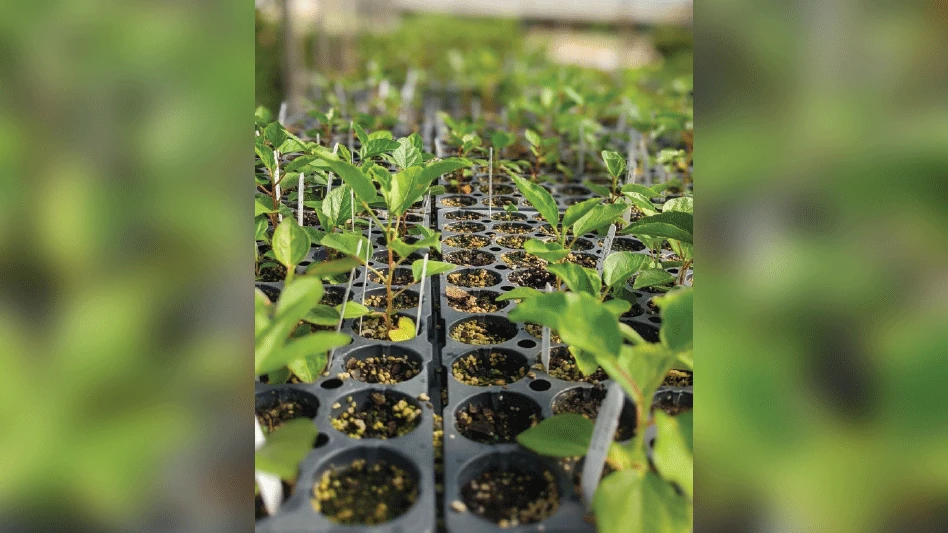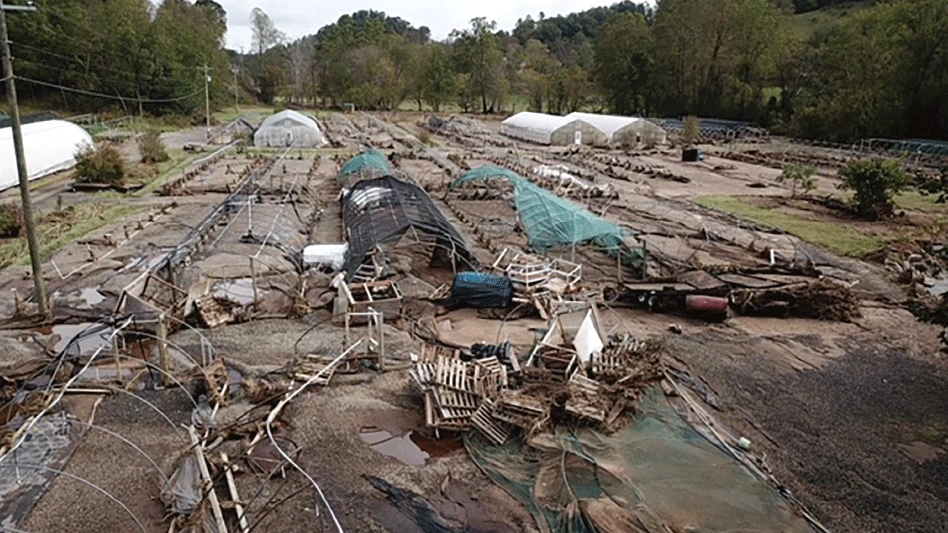Runoff from greenhouses and adjoining properties often contains pollutants in quantities that exceed legal standards set by federal, state and local regulatory agencies. These pollutants include fertilizers, pesticides and sediment.
{sidebar id=54}
Toxicity of greenhouse chemicals
Fertilizers contain nitrogen and phosphorus. These nutrients promote growth of algae and aquatic vegetation beyond what is naturally sustainable and also reduce water clarity.
When unchecked, the growth can cover the entire surface of a pond or lake. Algae “bloom” depletes oxygen, killing fish.
Fertilizer nitrogen can contaminate drinking water supplies. This is particularly a problem in groundwater. Pesticides differ greatly in their degree of toxicity. In general, insecticides that contaminate water bodies can have high toxicity to fish and other aquatic organisms, even in trace amounts. In addition, some herbicides have high toxicity to aquatic plants. Contamination of groundwater by pesticides is a human health concern.
In addition to chemicals for controlling pests, there are other agricultural and household chemicals used in greenhouse production that could potentially contaminate water. These include postharvest chemical treatments, growth regulators (that are classified as pesticides), exterior shading compounds and household cleaning and disinfectant products. Large quantities of these materials could be damaging if spilled in a small stream, into sanitary sewage treatment systems or allowed to percolate into groundwater.
Storm runoff from greenhouse roofs may contain pollutants such as toxic sediments and shading compounds. If roof runoff is not properly directed, it may flow across areas where contaminants are washed into the municipal storm water, sewer systems or agricultural drainage systems.
Disposal precautions
Care is needed when disposing of greenhouse chemicals, especially the anti-ethylene postharvest treatment silver thiosulfate (STS). Silver is a heavy metal that persists in soil and water and may pollute drinking water. STS is very toxic to aquatic organisms. When absorbed by the body, heavy metals accumulate and, at toxic levels, affect the nervous system.
Greenhouse shading compounds also require careful use and disposal. Exterior shading compounds can contain latex paint that is toxic to marine life. They may contain ethylene glycol that can also be hazardous to humans. Some greenhouse shading compounds contain sodium hydroxide which is strongly alkaline. These products must be disposed of properly because alkaline substances can be toxic to fish.
Sediment is not sedentary
Sediment refers to the loose particles of clay, silt and sand that suspend in a body of water and eventually settle to the bottom. Suspended sediment clouds the water, preventing light from penetrating to aquatic plants. This includes underwater grasses, submerged aquatic vegetation and phytoplankton (microscopic algae). Reduced light affects the ability of these plants to produce food through photosynthesis. This results in fewer plants to serve as food for other aquatic organisms. In this manner, sediment disrupts the food chain. Sediment also interferes with the physiological function, feeding and reproduction of fish and aquatic organisms.
Water-induced erosion is the process by which the surface of the soil gets worn down by water. It begins when rain or irrigation water loosens soil or container media particles. Erosion produces excess sediment that clogs streams and ditches, often causing flooding. Sediment that leaves the greenhouse property can make its way into nearby streams, where it impacts the health of aquatic ecosystems. Sediment is of special concern because of its role as a carrier of other pollutants such as phosphorus and pesticides.
Greenhouse production challenge
Growing high-quality plants requires large amounts of water, fertilizer and pesticides. The challenge for growers is that these high inputs increase the potential for both surface and groundwater pollution.
Many greenhouses apply more water than plants need. This is partly due to untrained staff that often irrigates crops. In their zeal to produce rapidly growing plants, these employees overcompensate and apply too much water. Inefficient irrigation systems with poor water distribution lead to overwatering.
Growers who use irrigation water of marginal quality often leach to prevent salts accumulation in the root zone. Excessive leaching leads to greater runoff volumes. Nutrients and pesticides carried by leached water can contaminate groundwater and surface water.
Fertilizer use on ornamentals is very intensive due to the high demand for nitrogen by greenhouse crops. In many cases, more than half of the fertilizer nitrogen applied to ornamental crops is lost to leaching.
The potential for fertilizer leaching is compounded when growers overwater. Fertilizer runoff from many greenhouse operations still exceeds the federal drinking water standard of 10 parts per million nitrate-nitrogen.
Pesticide use on greenhouse crops is usually more intensive than on most other agriculture crops. The heavy pesticide use, when coupled with intensive irrigation regimes, poses significant risks for contamination of surface and groundwater.
Greenhouse growers often use organophosphate and synthetic pyrethroid insecticides. They have high toxicities to aquatic organisms and can cause adverse effects on ecosystems. It is this eco-toxicological consideration that drives the regulation of pesticide runoff.
What’s the solution?
How do you balance the requirements of your crops with the moral and legal obligations to protect water quality and still make a profit? It is critical that you understand how pollutants in greenhouse runoff can contaminate water. Then implement management practices that protect against runoff and groundwater leaching. If runoff is still a problem, consider basins or filter strips to keep runoff on your property. Many growers successfully recycle irrigation water or reuse collected roof runoff to irrigate non-crop or crop areas.
Work with managerial staff to determine environmental problems. Then develop a comprehensive water-quality plan to mitigate runoff and leaching. Keep records of the management practices you implement and changes you make. This can be useful not only in evaluating how your plan is working, but also in documenting your good stewardship for regulators.
{sidebar id=1}
- Julie Newman
Get curated news on YOUR industry.
Enter your email to receive our newsletters.Latest from Nursery Management
- November issue recap
- Trump threatens 25% tariffs on Mexico and Canada in move that could hurt horticulture
- Hold the line!
- Meet the All-America Selections AAS winners for 2025
- Exacto announces David Hollinrake as CEO
- AmericanHort accepting applications for HortScholars program at Cultivate'25
- BioWorks hires Curt Granger as business development manager for specialty agriculture
- 2025 Farwest Show booth applications now open







